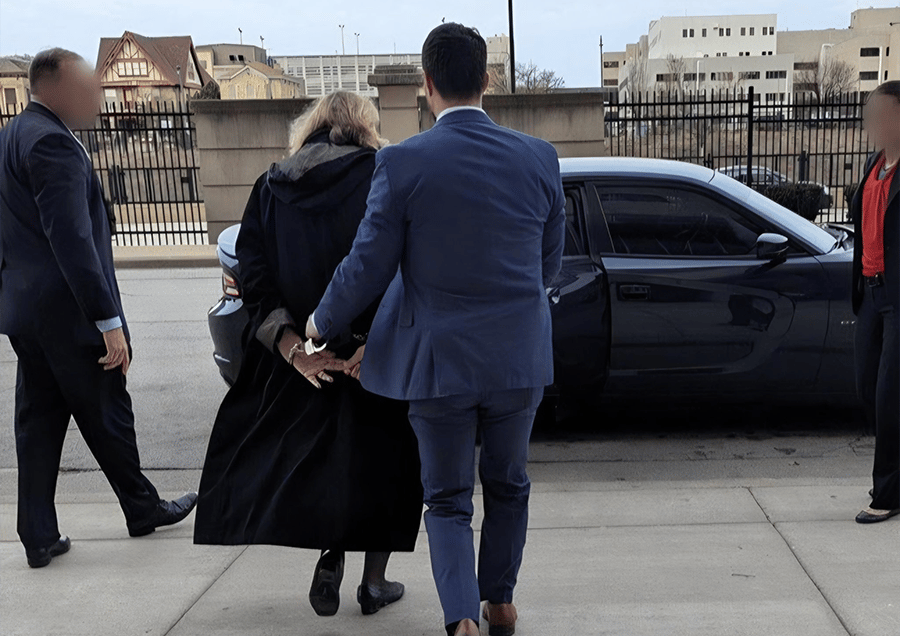Judges Under Fire: Is the Trump Administration Crossing a Line with Hannah Dugan’s Arrest?
4/29/20254 min read


Judges Under Fire: Is the Trump Administration Crossing a Line with Hannah Dugan’s Arrest?
The image is striking: a woman in a long coat, escorted by a man in a suit, flanked by FBI agents, with a black car waiting nearby. This isn’t a scene from a crime drama—it’s the arrest of Milwaukee County Circuit Court Judge Hannah Dugan on April 25, 2025, a moment that’s ignited a firestorm of debate about immigration enforcement, judicial independence, and the limits of federal power.
A Judge in Handcuffs: What Happened?
Last week, the FBI arrested Judge Hannah Dugan outside the Milwaukee County Courthouse, charging her with obstructing federal agents. The allegations? On April 18, Dugan allegedly helped Eduardo Flores-Ruiz, a 30-year-old undocumented immigrant facing misdemeanor battery charges, evade ICE agents by escorting him through a nonpublic jury door after his court appearance. According to FBI Director Kash Patel, Dugan “intentionally misdirected” agents, creating “increased danger to the public.” Flores-Ruiz was later apprehended, but the spotlight quickly turned to Dugan—and the Trump administration’s aggressive stance on immigration.
This isn’t an isolated incident. The administration has a history of clashing with judges, as seen in a 2019 case where a Massachusetts judge faced similar charges (later dropped in 2022). But Dugan’s arrest marks a new escalation, with the Justice Department openly targeting local officials who interfere with immigration enforcement. Attorney General Pam Bondi didn’t mince words on Fox News: “If you are harboring a fugitive, we don’t care who you are.”
The Bigger Picture: Immigration Crackdown vs. Judicial Independence
The Trump administration’s immigration policies have been a lightning rod since day one. A January 2025 Justice Department memo directed federal prosecutors to investigate and charge local officials who impede immigration enforcement, signaling a crackdown on so-called “sanctuary” jurisdictions. Milwaukee’s ICE office has already made multiple arrests at Dugan’s courthouse this year, focusing on undocumented immigrants with criminal charges. But arresting a sitting judge? That’s a bold move—and one that’s raising serious questions.
Critics like Rep. Jamie Raskin (D-Md.) call it “a whole new descent into government chaos,” arguing that the administration is weaponizing federal law enforcement to undermine judicial autonomy. Former judge Andrew Napolitano, speaking to Breitbart News, accused the administration of a “jihad against judges,” suggesting they’re making an example of Dugan to send a message. On X, users like @glennkirschner2 echoed this sentiment with a fiery post: “HANDS OFF OUR JUDGES! IT’S THE SEPARATION OF POWERS, STUPID!”
The Other Side: Accountability or Overreach?
Supporters of the arrest, however, see it as a necessary step to uphold the law. On X, @BrianHegseth pointed out that both male and female judges have been arrested for similar actions, pushing back against narratives that frame Dugan’s arrest as gender-based. “The story isn’t that a judge was arrested,” he wrote. “THE STORY IS that a judge ILLEGALLY obstructed federal agents & helped a foreign criminal avoid arrest.” Others, like @CliffCopeland5, celebrated the move, saying they’d “vote twice for Trump” if they could, applauding the administration for tackling “corrupt judges.”
The Trump administration has doubled down. White House deputy chief of staff Stephen Miller declared on social media: “No. One. Is. Above. The. Law.” And with reports that the administration is even willing to arrest Supreme Court justices for harboring undocumented immigrants, the message is clear: no one is off-limits.
A Clash of Powers: What’s at Stake?
Dugan’s arrest isn’t just about one judge or one immigrant—it’s about the balance of power between federal and state authorities. Milwaukee’s ICE office operates under a policy allowing arrests “in or near courthouses” when there’s credible information about a target’s appearance, a directive from a January 2025 memo. But critics argue this erodes the judiciary’s ability to function independently. If judges fear federal retaliation for their courtroom decisions, how can they uphold justice impartially?
On the flip side, the administration argues that judges who obstruct federal law enforcement are abusing their authority. Immigration courts are already overwhelmed—there were nearly 4 million pending cases in late 2024, including 1.5 million asylum cases. Firing immigration judges (as Trump has done recently) and arresting local judges like Dugan only adds fuel to the fire, with critics warning of a growing backlog and erosion of due process.
Where Do We Go From Here?
Dugan has hired former U.S. Attorney Steven Biskupic to defend her and was released on bond, with a hearing scheduled for May 15, 2025. Her case will likely become a litmus test for how far the federal government can go in policing judicial conduct. But beyond the legal battle, the broader implications are chilling. Are we witnessing a necessary crackdown on judicial overreach, or a dangerous assault on the separation of powers?
As this story unfolds, one thing is clear: the tension between immigration enforcement and judicial independence isn’t going away anytime soon. And with the Trump administration showing no signs of backing down, more clashes are likely on the horizon.
What Do You Think?
- Should judges face federal charges for actions taken in their courtrooms, or does this undermine the separation of powers?
- Is the Trump administration’s immigration crackdown a necessary step to secure the border, or an overreach that threatens due process?
- How should the judiciary balance its role in upholding justice with the federal government’s immigration enforcement priorities?
Let’s hear your thoughts in the comments below.
hello@boncopia.com
+13286036419
© 2025. All rights reserved.